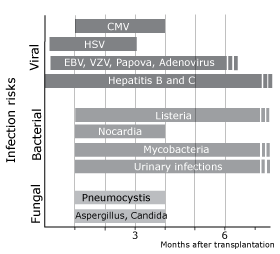Post transplant infection
| Chronology of post transplant infection |
 |
CMV: Cytomegalovirus
EBV: Epstein-Barr virus |
HSV: Herpes simplex virus
VZV: Varicells zona virus |
|
|
Determinants of the host (quality and quantity of immune
effectors, underlying disease, age), of the graft (organ type, HLA-mismatching,
injury, permissiveness for virus infection) and of the virus (genus, organ
tropism, fitness, antiviral resistance) define the risk of viral infection,
morbidity and mortality in organ transplantation. This "menage-à-trois"
of host, graft and virus is influenced by dose- or magnitude-dependent
factors denoted modulators such as the type and dose of immunosuppression,
the degree of local and systemic inflammatory patterns as well as use of
immunoglobulins or antivirals. Therefor, transplanted patient are at high risks for any type of infection espacially during the first months after the transplantation, when immunosuppression is stronger.
Most of the patinets are immunised against common virus like CMV or EBV. However immunosuppression therapy put the patient at high risk of CMV reactivation espacially after treatment for rejection episode. Primo-infection with EBV (mainly children and young adults) is at high risk for developpement of PTLD (Posttransplantation Lymphoproliferative Disorders).
After six months following transplantation, opportunistic infections become
less likely.
|



 Print
Print